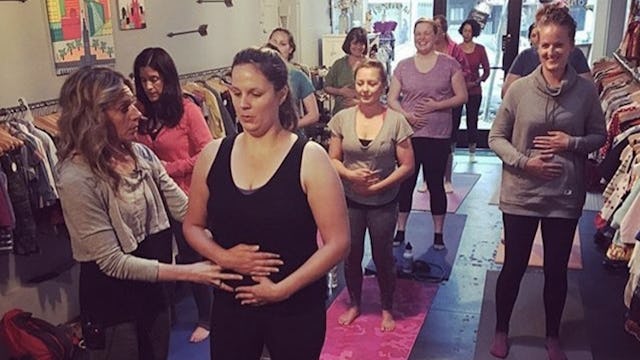Abs Separate After Pregnancy? This Exercise, 10 Minutes A Day, Will Help

A personal trainer and an OB-GYM teamed up to find a solution to diastasis recti
The “mummy tummy” many women develop after a long, hard pregnancy and birth is widely seen as a souvenir of motherhood. But for some moms, the post-baby pooch of belly flesh goes beyond being merely an annoyance when trying to fit into old jeans — it actually hurts.
That’s when the pooch is caused by diastasis recti, a condition where abdominal muscles separate after a mom gives birth. The good news? There’s a way to make it better — and according to those who developed it, results only take a couple of weeks.
RELATED: Let’s Get Physical! What Postpartum Workouts Are Safe After Giving Birth?
According to NPR, personal trainer Leah Keller and Dr. Geeta Sharma, an OB-GYN at Weill Cornell Medical Center-New York Presbyterian Hospital, came up with a solution for repairing diastasis recti — and even preventing it while a mom is still pregnant.
It’s called the “The EMbody program by Every Mother” method and it makes some pretty exciting promises.
Michaeleen Doucleff of NPR attended a class Keller teaches in San Francisco where she instructs women in learning the exercise she’s developed to eliminate the post-baby separation of the abs. “We will see a dramatic change,” says Keller to the class. “You can easily expect to see 2 inches off your waist in three weeks of time,” Keller says. “That’s not an unrealistic expectation.”
Well holy shit, teach us your ways.
Keller explains that she and Dr. Sharma have done a study on the program and that it truly works. “We found 100 percent of women achieved full resolution,” she says.
Sharma calls disastasis recti a “ubiquitous issue” for moms and says it goes beyond a change in the appearance of the stomach. “People can start feeling some back pain because the core is weakened,” she explains.
During pregnancy, a gap opens between the ab muscles, around the belly button. Sometimes, that gap closes up on its own after a woman gives birth.
Sometimes, it doesn’t.
When the gap doesn’t resolve itself, it leaves an opening where organs and overlying tissue can bulge out, which is what causes the mommy pooch. Dr. Linda Brubaker, an OB-GYN at the University of California, San Diego, explains that while an internet search will turn up a number of ways to fix the separation, not all of them work. “Some of it is actually potentially harmful,” she cautions.
Keller echoes Brubaker and says moms need to be picky with the ab exercises they do post-baby. “You have to be very careful,” she says. “For example, please don’t ever again in your life do crossover crunches or bicycle crunches. They splay your abs apart in so many ways.”
Yikes.
So by now, you’re probably wondering — what does work?
There’s costly courses women can take that are supported by doctors and therapists, but Dr. Raul Artal, an OB-GYN at St. Louis University, says the best way is prevention in the first place by exercising the abs during pregnancy.
“There’s a general knowledge that exercise is going to help,” Sharma says. “But no one has really tested them in a standardized way.” And that’s what she and Keller set out to change. A pilot study of 63 women doing the exercise Keller teaches in her classes showed very promising results. All of the women had full resolution of their diastasis recti in just 12 weeks of doing “The EMbody program” method for 10 minutes a day.
In the class, Doucleff follows Keller’s instructions. “The exercise is a very small, very intense movement. That’s almost imperceptible,” Keller says.
The women sit on the floor cross-legged, hands on bellies, doing deep breaths. Keller tells them, “Let the belly fully expand.”
As the women exhale, they suck in their abdominal muscles as far back as they can toward their spines. “Now we’re going to stay here near the spine. Hold this position,” says Keller.
Then, tiny breaths, and with each exhale, they push their stomachs back further. The class is now four weeks in and after repeating the exercise the prescribed number of times (having also done it for 10 minutes each day at home in between classes), Keller comes around with a tape measure to check progress.
The results? Amazing, according to Keller’s measurements. Several women have not only lost inches from their bellies, many have closed up their separation already. Doucleff’s separation hasn’t closed yet, but after three weeks, she’s lost an inch from her stomach and her back pain is almost gone.
For moms dealing with this issue that’s equal parts annoying and painful, this could be the answer to their troubles, according to Keller and Sharma’s research. No one should feel shame for having a little belly after birth, but no one should have back and stomach discomfort either.
Consult with a physician before attempting any new exercise regimen post-pregnancy.
This article was originally published on